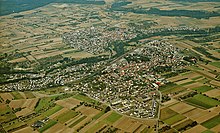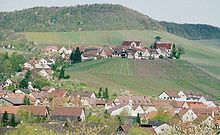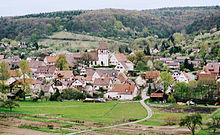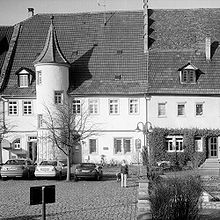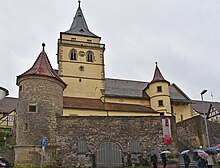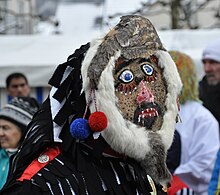Sachsenheim
| coat of arms | Germany map | |
|---|---|---|

|
Coordinates: 48 ° 58 ' N , 9 ° 4' E |
|
| Basic data | ||
| State : | Baden-Württemberg | |
| Administrative region : | Stuttgart | |
| County : | Ludwigsburg | |
| Height : | 246 m above sea level NHN | |
| Area : | 57.92 km 2 | |
| Residents: | 18,794 (Dec. 31, 2018) | |
| Population density : | 324 inhabitants per km 2 | |
| Postal code : | 74343 | |
| Primaries : | 07147, 07046 | |
| License plate : | LB, VAI | |
| Community key : | 08 1 18 076 | |
| LOCODE : | DE SSN | |
City administration address : |
Outer castle courtyard 5 74343 Sachsenheim |
|
| Website : | ||
| Mayor : | Holger Albrich | |
| Location of the city of Sachsenheim in the Ludwigsburg district | ||
Sachsenheim is a town in the district of Ludwigsburg in Baden-Württemberg . It has around 18,600 inhabitants and belongs to the Stuttgart region as well as to the outskirts of the European metropolitan region of Stuttgart .
geography
location
Sachsenheim is a municipality with a southeast-northwest extension of about 17 kilometers. Groß- und Kleinsachsenheim are located at the confluence of the Kirbach in the Metter , which flows into the Enz in the neighboring Bietigheim-Bissingen . The city center is about 14 km from the district town of Ludwigsburg . The districts of Hohenhaslach, Ochsenbach / Kirbachhof, Spielberg and Häfnerhaslach are located in the Kirbach valley in the southwestern part of the Stromberg . The center of Großsachsenheim is about 250 m above sea level. The highest point is the Baiselsberg near Hohenhaslach at 477 m, the lowest point is the Metter on the border with Bietigheim-Bissingen at 196 m.
City structure
Sachsenheim consists of the districts Großsachsenheim, Kleinsachsenheim, Hohenhaslach , Ochsenbach , Spielberg and Häfnerhaslach . The districts are former communities of the same name; in the districts of Hohenhaslach, Ochsenbach, Spielberg and Häfnerhaslach, localities are set up in the sense of the Baden-Württemberg municipal code with their own local council and a local mayor as its chairman. The Großsachsenheim district includes the town of Großsachsenheim, the hamlet of Egartenhof and the Eichwald house. The Häfnerhaslach district includes the village of Häfnerhaslach and the abandoned village of Heimburg. The Hohenhaslach district includes the village of Hohenhaslach, the ducal domain and hamlet of Rechentshofen and the Kelterle house . The Kleinsachsenheim district includes the village of Kleinsachsenheim and the Obere Mühle house, as well as the abandoned village of Borzingen. The Ochsenbach district includes the village of Ochsenbach, the hamlet of Kirbachhof and the Bromberg house, as well as the abandoned villages of Nirbenhof (Unterbromberg) and Schippach. The village of Spielberg is part of the Spielberg district.
Neighboring communities
The following cities, communities and districts border the city of Sachsenheim. They are named clockwise starting in the north: Bönnigheim , Freudental , Löchgau , Bietigheim-Bissingen , Unterriexingen (town of Markgröningen ), Oberriexingen , Sersheim , Vaihingen an der Enz (all districts of Ludwigsburg ), Sternenfels ( Enzkreis ), Zaberfeld , Pfaffenhofen , Güglingen and Cleebronn (all districts of Heilbronn ).
Division of space

According to data from the State Statistical Office , as of 2014.
history

History of Großsachsenheim
Sachsenheim was first mentioned in a document in 1090. The family of the Lords of Sachsenheim named themselves after the place , who presumably had their ancestral seat on the "outer castle" and today's ruins of Altsachsenheim . At the latest after the construction of the moated castle Sachsenheim , which was built around 1400, its seat was in the community of Großsachsenheim, which was granted city rights in 1495. The Gothic building of the moated castle burned down in 1542 and was rebuilt by Reinhard von Sachsenheim in the Renaissance style. After he died in 1560 without a successor, the young town went to Württemberg in 1561 and was initially integrated into the Grüningen district with Kleinsachsenheim, Metterzimmer and Untermberg as a sub-district until Großsachsenheim became an independent district town in the 17th century.
The city lost around half of its inhabitants during and after the Thirty Years War . In the 18th and 19th centuries, crop failures and famines (including the famine of 1816/17) caused a further decline in the population. Sachsenheim became a purely agricultural village. During the implementation of the new administrative structure in the Kingdom of Württemberg , the Großsachsenheim office was dissolved in 1807 and a large part of the Vaihingen office was added.
The economic upswing began with the connection to the Württemberg State Railroad in 1853 (with its own station on the western line ) and the subsequent industrialization . During the administrative reform during the Nazi era in Württemberg , Sachsenheim came to the new district of Vaihingen in 1938 . During the Second World War, there was an Air Force airfield two kilometers southwest of Großsachsenheim (see the following subsection).
Since Großsachsenheim had become part of the American zone of occupation after the Second World War , the city had belonged to the newly founded state of Württemberg-Baden since 1945 , which became part of the current state of Baden-Württemberg in 1952.
On December 1, 1971, Kleinsachsenheim was incorporated into Großsachsenheim. On the same day the name of the city was changed to "Sachsenheim". On January 1, 1973 Hohenhaslach, Ochsenbach, Spielberg and Häfnerhaslach were incorporated. Because of the dissolution of the district of Vaihingen during the execution of the district reform in Baden-Württemberg , Sachsenheim was incorporated into the district of Ludwigsburg on January 1, 1973.
Großsachsenheim airfield
During the Second World War, the "Großsachsenheim" port of operations was located southwest of the town, on both sides of today's L1125. The location of the old runway south of the highway can still be seen very well on aerial photographs. It was expanded with forced labor by the Todt organization and in 1944/45 also with concentration camp prisoners . A “sick camp” was also set up at the airfield as a central assembly camp for severely ill forced laborers, including those from the nearby Bietigheim transit camp , where 668 Eastern European forced laborers, including 23 children and 33 young people, perished.
After the withdrawal of the German troops, the French Jagdgruppe 1/3 (GC 1/3) equipped with Spitfire Mk.VIII was located here in the last two weeks of the war .
Later during the Cold War , this was a position of the United States Army Nike Hercules .
History of the districts
Kleinsachsenheim
Kleinsachsenheim was first mentioned in a document in 1140. From the beginning there was a close relationship with Großsachsenheim. It is believed that Kleinsachsenheim was founded by a sideline of the Lords of Sachsenheim . The so-called Kleinsachsenheimer Linie built a castle in Kleinsachsenheim, later a palace. Both buildings no longer exist. In 1561, Kleinsachsenheim also went to Württemberg. The place survived the economic crisis times in the 17th and 18th centuries better than the neighboring Großsachsenheim and at that time was at times the larger of the two "Sachsenheims", which can also be seen from the fact that the Kleinsachsenheimer wine press is complete, the Großsachsenheimer only partially stone walls.
Kleinsachsenheim used to be surrounded by several towers and a curtain wall, which was rather unusual for villages. In 1971 the two places merged.
Hohenhaslach
In 800 plots were in Haselahe the Lorsch Abbey paid. As Haselahe or Haslach is time to understand today Kirbach creek and called his entire valley. The oldest settlement within this mark could probably be Niederhaslach, but the early sources only ever mention Haslach . The different place names Niederhaslach , Oberhaslach and Häfnerhaslach only developed over time. In 1283, a distinction was made between Haselach superiori et inferiori (Hohenhaslach and Niederhaslach) for the first time . For a long time Hohenhaslach was the largest and most important of today's suburbs of Sachsenheim. Due to the fortified expansion, the place was called a city in the 14th century, in the Gadner forest camp map from 1585 Hohenhaslach is the largest of the places.
Until the middle of the 13th century, Hohen-, Mittel- and Niederhaslach with Rechentshofen as well as Gündelbach, Horrheim and Ensingen belonged for the most part to the rule of noble lord Belrein von Eselsberg , who founded the Rechentshofen monastery with his wife Agnes von Bilversheim in 1241 . After he died around 1253 without a male successor, his property passed to the Counts of Vaihingen through his heir Agnes, who was married to Count Konrad II of Vaihingen . When the last male representative Heinrich died in 1364, the rest of the declining county with Eselsberg Castle came to the House of Württemberg through a settlement with his sister Mechthild von Vaihingen .
Häfnerhaslach
Häfnerhaslach probably goes back to a 1138 mentioned Hofgut the valley floor in Haslach back that the pin Speyer the monastery Odenheim left. The place was first mentioned in a document in 1403, Häfnerhaslach . The place name goes back either to the profession of the steward or to the Heffner family who lived there in the 15th century. In 1443, Count Ludwig von Württemberg bought the village from the Cistercian convent Frauenzimmern .
Ochsenbach
Ochsenbach has been documented since 1268. 1664 had Duke Eberhard III. build a hunting lodge, but only remnants remain. Numerous well-preserved half-timbered houses (the oldest house dates from 1559) testify to the prosperity of the wine-growing area. Ochsenbach is also known for his fossil finds: In 1936 Otto Linck found the skeleton of an early Plateosaurus. It is the oldest Plateosaurus ever found in Europe.
Spielberg
Spielberg is the smallest of the three forest villages and was first mentioned in 1161. Opposite in the Middle Ages was the Bromberg Castle with a manor and the hamlet of Bromberg , of which the Bromberger Mühle and the state domain of Bromberger Höfe still remind us today .
Religions
Until the introduction of the Reformation in the 16th century, the parishes in Sachsenheim and the surrounding villages belonged to the Land Chapter Vaihingen in the Archdeaconate Trinity of the Diocese of Speyer . Since then, today's districts of Sachsenheim have been predominantly evangelical . In the different parts of the city there are four parishes of the Evangelical Church with a total of five churches. In addition, there is an Evangelical Methodist church in Kleinsachsenheim and Hohenhaslach, and in Großsachsenheim there is a people's mission of committed Christians and the regional church of southern Germany . In addition, there have been three New Apostolic congregations in Großsachsenheim, Kleinsachsenheim and Hohenhaslach since the early 20th century .
After the Reformation, the few Catholic citizens were parish only after Michelsberg . After that, the Bietigheim parish office was responsible for the surrounding area. After many Catholic expellees settled in Sachsenheim as a result of the Second World War, a Roman Catholic parish was established again on site . Today the Catholic parish includes the Franziskuskirche in Großsachsenheim and the branch church Zum Heiligen Kreuz in Ochsenbach.
The Turkish-Islamic culture and sports association DITIB Mimar Sinan Mosque has existed in Sachsenheim since 1997 . The clubhouse also includes an Ottoman-Turkish style mosque .
politics
Municipal council
In Sachsenheim, the municipal council is elected using the spurious sub-district election. The number of local councils can change due to overhang mandates . Sachsenheim's municipal council has 26 members after the last election (2014: 23). The local election on May 26, 2019 led to the following final result. The municipal council consists of the elected voluntary councilors and the mayor as chairman. The mayor is entitled to vote in the municipal council.
Even before the constituent meeting, someone elected from the FW's list decided to join the municipal council as an individual. This results in a shift in the number of seats compared to the election result: the strongest parliamentary groups are the GLS and the CDU, each with 7 seats, followed by the FW with 6, the SPD with 3, the FDP with 2 seats and 1 non-attached party.
| Parties and constituencies |
% 2019 |
Seats 2019 |
% 2014 |
Seats 2014 |
||
| FW | Free voters Sachsenheim | 26.75 | 7th | 27.63 | 6th | |
| GLS | Sachsenheim Green List | 26.72 | 7th | 18.30 | 4th | |
| CDU | Christian Democratic Union of Germany | 26.11 | 7th | 32.61 | 8th | |
| SPD | Social Democratic Party of Germany | 12.19 | 3 | 15.91 | 4th | |
| FDP | Free Democratic Party | 8.23 | 2 | - | - | |
| AfD | Alternative for Germany | - | - | 5.54 | 1 | |
| total | 100.0 | 26th | 100.0 | 23 | ||
| voter turnout | 56.07% | 49.1% | ||||
mayor
Holger Albrich has been Mayor of Sachsenheim since May 2019. On February 3, 2019, he was elected in the first ballot with 54.62% of the vote. The turnout was 50.8%.
badges and flags
City coat of arms and flag

|
Even after the renaming and incorporation, the city carries the coat of arms and the flag of Großsachsenheim. This shows "in silver under a lying black deer pole a red buffalo horn with grind". The buffalo horns come from the coat of arms of the Lords of Sachsenheim (first documented in 1284), the stag stalk from the House of Württemberg . On September 6, 1966, Großsachsenheim was also awarded a flag in the colors red and white. |
Former municipal coat of arms
The communities that were dissolved in Sachsenheim had their own coats of arms:
- Häfnerhaslach: In blue, a golden clay jug between two golden hazelnut branches crossed at the bottom.
- Hohenhaslach: In a split shield in front in gold three black stag poles lying on top of each other, behind in gold on a green mountain an upright sitting red hare. On February 15, 1956, Hohenhaslach also received a flag in the colors red and yellow.
- Kleinsachsenheim: In red, two silver buffalo horns with a silver grind, a silver sword in between.
- Ochsenbach: In silver on green ground, a standing red ox.
- Spielberg: In gold, a shepherd in green, dressed in green, sitting on a green mountain with red shoes, a red shepherd's bag and a red hat feather, who blows on a naturally colored goat-shaped bagpipe with red flutes and a red mouthpiece.
Coat of arms of the Lords of Sachsenheim
|
|
|
- Gravestone of the minstrel Hermann von Sachsenheim , detail: buffalo horn coat of arms with grind, 1508, Stuttgart, collegiate church .
- Epitaph of Wilhelm von Janowitz and Anna von Sachsenheim, 1553, Tübingen, collegiate church . - Right at the corners: two buffalo horn coats of arms with grind and horns bent outwards or inwards.
- Altarpiece by Jörg von Sachsenheim , 1489, Stuttgart, Hospital Church . - Right: inclined buffalo horn coat of arms with grind and outwardly curved horns, above: helmet with inwardly curved horns.
Town twinning
There is a town partnership with Valréas , France (since 1994).
Culture and sights
The districts in the Kirbachtal are on the Württemberg Wine Route . In Ochsenbach there is a cultural and historical wine trail and a historical, renatured vineyard with dry stone walls and rare plants and insects, the Ochsenbacher Geigersberg .
Museums
The city has a city museum that deals with the history of the city and its neighborhoods. There is also a fire brigade museum in Kleinsachsenheim .
Buildings
- The most important sight is the moated castle in Großsachsenheim. Built in the 14th century, burned down in 1542 and rebuilt in 1544. According to a legend, when the first castle burned, the castle ghost " Klopferle " played a role . The knocker is immortalized as a stone figure at the gate entrance of the castle. In 1952 the castle was acquired by the city of Großsachsenheim and has been the town hall since 1962.
- Protestant town church “St. Fabian and Sebastian ”in Großsachsenheim, former fortified church , first mentioned in 1265
- Remains of the old city wall with defense tower (Sachsenheim was never completely surrounded by a city wall)
- Ruin Altsachsenheim above the Enztal near Untermberg
- Evangelical town church of Kleinsachsenheim, former fortified church ( loopholes on the church tower), rebuilt in 1460 and 1619, reconstruction 1948–1950
- Town hall of Kleinsachsenheim, half-timbered building, first mentioned in 1614
- Parish Church “St. Georg “Hohenhaslach, around 1230. Valuable early Gothic frescoes (discovered during interior renovation in 1957)
- Dorfstraße Ochsenbach, half-timbered houses from the 16th to 18th centuries
- Protestant parish church "Our Lady" Ochsenbach, built around 1290, Gothic frescoes from 1430
- Protestant church “St. Remigius "Häfnerhaslach, Gothic choir with ribbed vault, frescoes (around 1400)
- Rundlingstraße Häfnerhaslach, half-timbered houses from the 16th and 17th centuries
- In Rechentshofen remains of the Rechentshofen monastery are preserved, which were absorbed in the farm yard of the domain there.
- The Brackenheim 1 telecommunications tower is located north of Ochsenbach .
Art and culture associations
-
Choirs
- Eintracht Kleinsachsenheim e. V. The male choir Eintracht Kleinsachsenheim has been formed since 2013 under the name of the male choir LS. The singing community currently consists of 32 active choir members from the communities of Löchgau and Kleinsachsenheim.
- Kolping Choir Sachsenheim
- Liederkranz MGV Ochsenbach
- Liederkranz 1847 Großsachsenheim e. V.
- Liederkranz Hohenhaslach 1831 e. V. The Hohenhaslach Liederkranz consists of the Stromberg mixed choir vocal ensemble, which organizes one or two concerts or performances each year with around 40 active singers. A women's choir has been expanding the musical program since March 2016.
- Liederkranz Häfnerhaslach e. V.
-
Wind band
- Musikverein Stadtkapelle Sachsenheim e. V. Founded in 1923, the Musikverein Stadtkapelle Sachsenheim e. V. (MVS) one of the oldest and largest cultural associations in the city. With four wind orchestras, the MVS, which has had the title addition Stadtkapelle since 1960, offers a musical range for every age and ability level.
- Musikverein Hohenhaslach 1920 e. V. Hohenhaslacher musicians
- Musikverein Ochsenbach e. V. Founded 60 years ago, the Musikverein Ochsenbach with over 300 members is now one of the largest clubs in Ochsenbach . For over half a century, the music association has contributed to cultural life in and around Ochsenbach and has delighted many people at concerts and events.
Regular events
- Urzelnlauf on Carnival Saturday
- Local festival every five years
- Grocer's market in Hohenhaslach (always on May 1st)
- Summer at the castle (always on the third weekend in July)
- Sachsenheimer Summer Special (always on the third weekend in September)
- Wengerter Advent on the Panoramaweg in Hohenhaslach (always on the first weekend in Advent)
- Christmas market in the outer courtyard (always on the second Advent)
Economy and Infrastructure
Viticulture
The districts of Kirbachtal and Kleinsachsenheim look back on a long history of viticulture . Approx. 250 hectares of the municipal area of the city consist of vineyards . The sites belong to the large area "Stromberg" in the "Württembergisch Unterland" area of the Württemberg wine-growing region .
traffic
Sachsenheim is around 30 kilometers from the state capital Stuttgart .
- Car: Autobahn exit Ludwigsburg-Nord ( A 81 ), continue on B 27 and L 1125 to Großsachsenheim
- Rail: Sachsenheim is connected to the Württemberg Westbahn ( Bietigheim-Bissingen - Bruchsal ) with the Sachsenheim train station in the Großsachsenheim district ; the station serves the regional express line Stuttgart –Bietigheim-Bissingen– Mühlacker - Heidelberg , the regional express line Stuttgart – Bietigheim-Bissingen – Mühlacker– Pforzheim - Karlsruhe as well as the light rail lines S5 / S6 (Bietigheim-Bissingen – Mühlacker –Pforzheim – Karlsruhe– Wörth or Bietigheim-Bissingen – Mühlacker – Pforzheim– Wildbad ) of the Karlsruhe Stadtbahn as a stopping point. Sachsenheim is part of the Stuttgart Transport and Tariff Association (VVS) . The nearest S-Bahn station in Stuttgart is in Bietigheim-Bissingen.
Public facilities
There are two retirement homes and one nursing home belonging to the district's own clover leaf nursing home .
education
With the Lichtensterngymnasium , the Eichwald- Realschule Sachsenheim, the Burgfeldschule ( elementary and secondary school with Werkrealschule ) and the Kraichertschule ( special school ), all in Großsachsenheim, the Kirbachschule (elementary and secondary school with Werkrealschule) in Hohenhaslach and the elementary school in Kleinsachsenheim a wide range of educational opportunities. There are also seven Protestant and three municipal kindergartens.
Companies
- Porsche , sports car manufacturer, logistics center
- Winkels beverages logistics , logistics center
- Kienle + Spiess , production
- The Kreissparkasse Ludwigsburg operates branches in the suburbs Großsachsenheim, Kleinsachsenheim, Häfnerhaslach and Hohenhaslach, which belong to the regional directorate Bietigheim.
sons and daughters of the town
- Hermann von Sachsenheim (1365–1458), poet
- Eberhard David Hauber (1695–1765), born in Hohenhaslach, theologian
- Ferdinand Schnaidt (1840–1910), born in Hohenhaslach, bank director, member of the state and Reichstag
- Thomas Knodel (* 1953), church musician
Others
The city of Sachsenheim became known nationwide when it became known that the terrorists Christian Klar , Knut Folkerts and Günter Sonnenberg had set up in a residential and business complex opposite the train station for several weeks. Here, after the attack on Siegfried Buback , the police found the getaway car - a silver-gray Alfa Romeo Giulia - and then carried out a large-scale search.
Duckwick is a goblin figure from Sachsenheim.
literature
- The Mörin . Quarterly publication of the history association on local history.
- Karl Eduard Paulus : Description of the Oberamt Vaihingen . Issued by the Royal Bureau of Statistics and Topography. Hallberger, Stuttgart 1856. pp. 145 ff. Wikisource .
- Sachsenheim, gateway to Stromberg. Published by the city of Sachsenheim. Sachsenheim 1975.
Individual evidence
- ↑ State Statistical Office Baden-Württemberg - Population by nationality and gender on December 31, 2018 (CSV file) ( help on this ).
- ^ The state of Baden-Württemberg. Official description by district and municipality. Volume III: Stuttgart District, Middle Neckar Regional Association. Kohlhammer, Stuttgart 1978, ISBN 3-17-004758-2 . Pp. 447-451.
- ↑ State Statistical Office, area since 1988 according to actual use for Sachsenheim.
- ↑ Doubted by the Baden-Württemberg State Monuments Office. See the database of the State Monuments Office for the Altsachsenheim ruins
- ^ Federal Statistical Office (ed.): Historical municipality directory for the Federal Republic of Germany. Name, border and key number changes in municipalities, counties and administrative districts from May 27, 1970 to December 31, 1982 . W. Kohlhammer, Stuttgart / Mainz 1983, ISBN 3-17-003263-1 , p. 452 .
- ^ Federal Statistical Office (ed.): Historical municipality directory for the Federal Republic of Germany. Name, border and key number changes in municipalities, counties and administrative districts from May 27, 1970 to December 31, 1982 . W. Kohlhammer, Stuttgart / Mainz 1983, ISBN 3-17-003263-1 , p. 453 .
- ↑ Memorial sites for the victims of National Socialism. A documentation. Vol. I, Bonn 1995, p. 74, ISBN 3-89331-208-0 .
- ↑ GC I / 3, Ciel Gloire / Aéro-Journal N ° 10: December 1999 - January 2000
- ↑ Source: WUB Volume III, No. 950, pp. 454–455 WUB online
- ↑ "Mechthild von Vaihingen, Count Friedrichs von Zollern married landlady, sells to Count Eberhard II., Ulrich IV. And Ulrich her father's claims to the legacy of her brother Count Heinrich for 7500 pounds Heller." Source: LABW, HStA Stuttgart, A 602 No. 14113 LABW online .
- ^ Website of the city of Sachsenheim ( memento of July 13, 2009 in the Internet Archive ) on Spielberg, accessed on June 30, 2011.
- ↑ Election information from the municipal data center
- ^ Decision in Sachsenheim
- ^ Wolfgang Merz: Website of the choir Eintracht Kleinsachsenheim e. V. Retrieved October 19, 2016 .
- ↑ Website of the song wreath Hohenhaslach e. V. In: www.liederkranz-hohenhaslach.de. Retrieved October 19, 2016 .
- ↑ Website of the Musikverein Stadtkapelle Sachsenheim e. V. In: Musikverein Stadtkapelle Sachsenheim e. V. Retrieved October 19, 2016 .
- ↑ Annabelle Diez: Website of the Hohenhaslacher Musikanten. Retrieved October 19, 2016 .
- ^ Website of the Ochsenbach Music Club. Retrieved October 19, 2016 .
- ↑ Overview of the regional offices of the Kreissparkasse Ludwigsburg ( Memento of the original from April 12, 2013 in the web archive archive.today ) Info: The archive link was inserted automatically and has not yet been checked. Please check the original and archive link according to the instructions and then remove this notice.



